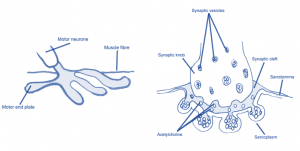The nerve impulse
Information is relayed from the brain to the muscle via a nerve impulse – an electrical current running the length of the nerve, starting at the brain and passing down the spinal column to the relevant cell body. The cell bodies of individual motor neurones are located in various regions of the anterior horn of the spinal column. These collections of cell bodies are called motor neurone pools. The cell bodies are positioned in relation to the muscle they stimulate.
The nerve impulse is passed along the axon of the motor neurone. The axon is covered in a myelin sheath. This sheath is mostly made up of fat and acts to insulate the nerve. The sheath is not continuous, and there are gaps known as nodes of Ranvier. The impulse is passed from one node of Ranvier to the next, rather than along the whole length of the axon – allowing the impulse to travel more quickly. This method of impulse propagation (transmission) is called salutatory conduction and the thicker the myelin sheath the faster the nerve impulse that can be conducted.
A muscle fibre is innervated when an impulse is of suitable strength. The point at which the motor nerve meets the muscle fibre is known as the motor end plate, and forms the neuromuscular junction.
When a nerve impulse arrives at the motor end plate, calcium ions enter the synaptic knob, and a transmitter called acetylcholine is released. This helps the spread of the impulse to the muscle fibre across a small gap called the synaptic cleft. If sufficient acetylcholine is released, there is a change in the permeability of the sarcolemma to sodium and potassium ions – now giving the muscle fibre ‘action potential’ – the capability to contract.
An incoming response may be either excitatory or inhibitory. An excitatory response which causes muscle contraction will produce an excitatory post-synaptic action potential (EPSP), which will cause a contraction of muscle fibres if a given threshold or intensity is reached or exceeded. If this threshold is not attained, then the sum of the individual effects of several impulses can be used until the threshold is exceeded. Once this point is reached, a depolarisation (decrease in the electrical potential) across a membrane occurs, which triggers the release of calcium ions from the sarcoplasmic reticulum. This in turn removes the inhibitory effect of tropomysium and enables the myosin cross bridge to attach to the actin filament to cause muscle fibre contraction.
Following exhitation, a chemical called cholinesterase is released which blocks the effect of acetylcholine and prepares the muscle fibre for the arrival of subsequent stimuli, so that the muscle fibres in a given motor unit can once again contract.

